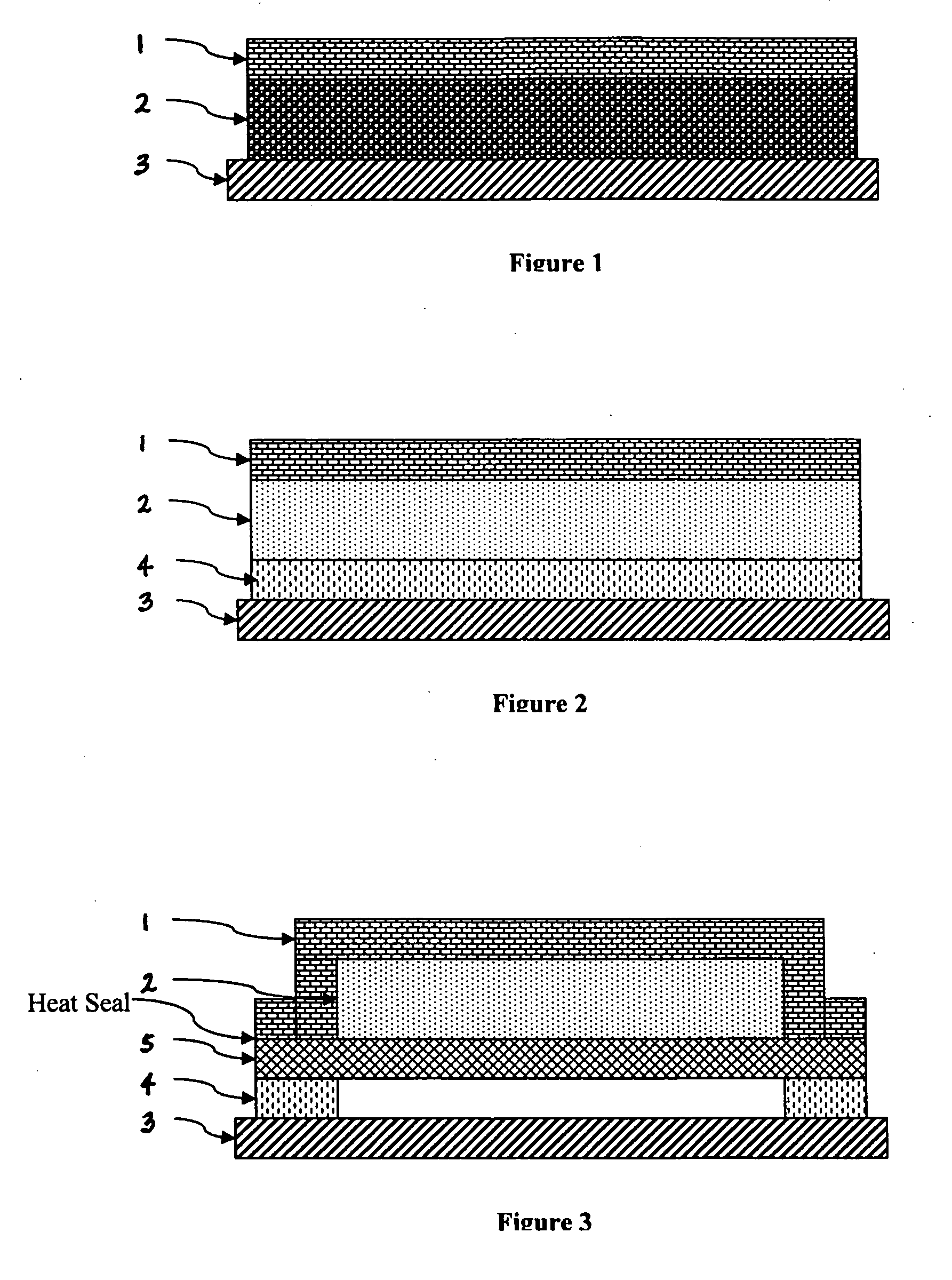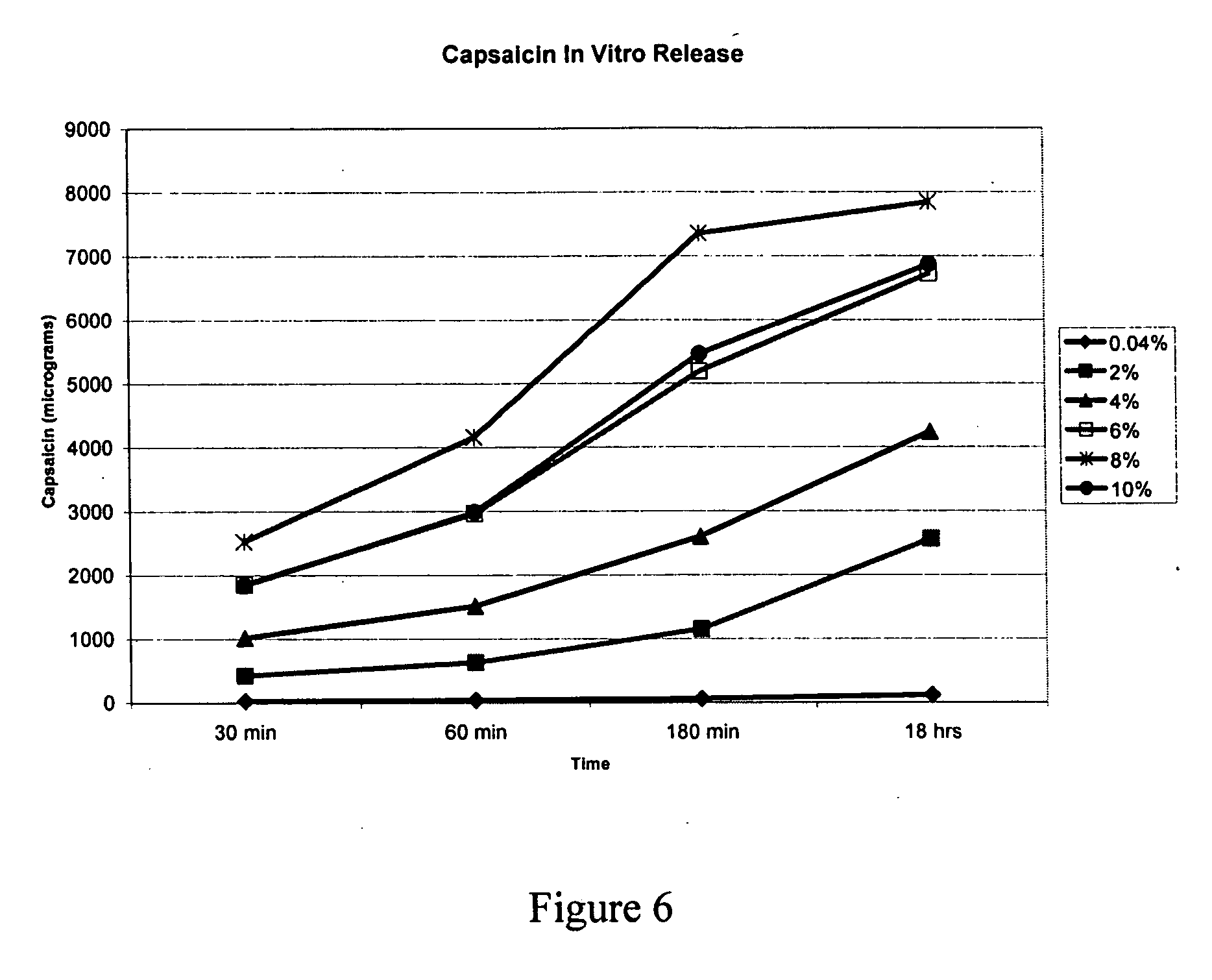Device for delivery of TRPV1 agonists
a technology of trpv1 and agonist, which is applied in the direction of biocide, plant/algae/fungi/lichens, drug compositions, etc., can solve the problems of not being able the use of this escaping water and non-hydrophilic penetration enhancer to increase the thermodynamic activity of the drug depot, and the inability to describe the delivery of capsaicin. to achieve the effect of preventing trans
- Summary
- Abstract
- Description
- Claims
- Application Information
AI Technical Summary
Benefits of technology
Problems solved by technology
Method used
Image
Examples
example 1
Preparation of a Microreservoir Device Containing 0.04% Capsaicin by Weight in the Drug Depot
[0086] To 80 mg of capsaicin, 16.0 grams of oleyl alcohol was added and the components were mixed. Ethyl cellulose, 200 mg, was then added and mixed thoroughly and set aside for two hours. Bio-PSA® 4201, 36.74 grams and Bio-PSA® 4301, 146.98 grams, were added and the adhesive mass was mixed vigorously until gelled mixture of olyel alcohol, capsaicin, and ethyl cellulose was uniformly dispersed as fine globules in the adhesive. The resulting adhesive matrix was subsequently coated on a release liner 3M™ Scotchpak™ 1022, and solvent n-heptane was dried by blowing hot air at a temperature between 35 to 40° C. Coating weight after the removal of the n-heptane was approximately 273.6 g / m2. The dried film was then laminated with the polyester backing layer, 3M™ Scotchpak™ 9733, and the finished drug delivery device was punched out (5 cm×5 cm). The punched drug delivery devices were then sealed in...
example 2
Preparation of a Microreservoir Device Containing 2.0% Capsaicin by Weight in the Drug Depot
[0087] To 4.0 grams of capsaicin, 20.0 grams of olyel alcohol was added and the components were mixed. Ethyl cellulose, 200 mg, was then added and mixed thoroughly and set aside for two hours. Bio-PSA® 4301, 175.80 grams was added and the adhesive mass was mixed vigorously until gelled mixture of olyel alcohol, capsaicin, and ethyl cellulose was uniformly dispersed as fine globules in the adhesive. The resulting adhesive matrix was subsequently coated on a release liner 3M™ Scotchpak™ 1022, and solvent n-heptane was dried by blowing hot air at a temperature between 35 to 40° C. Coating weight after the removal of the n-heptane was approximately 277.9 g / m2. The dried film was then laminated with the polyester backing layer, 3M™ Scotchpak™ 9733, and the finished drug delivery device was punched out (5 cm×5 cm). The punched drug delivery devices were then sealed into a sachet of a primary packi...
example 3
Preparation of a Microreservoir Device Containing 4% Capsaicin by Weight in the Drug Depot
[0088] To 8.0 grams of capsaicin, 36.0 grams of olyel alcohol was added and the components were mixed. Ethyl cellulose, 2.0 grams, was then added and mixed thoroughly and set aside for two hours. Bio-PSA® 4301, 154.0 grams was added and the adhesive mass was mixed vigorously until gelled mixture of olyel alcohol, capsaicin, and ethyl cellulose was uniformly dispersed as fine globules in the adhesive. The resulting adhesive matrix was subsequently coated on a release liner 3M™ Scotchpak™ 1022, and solvent n-heptane was dried by blowing hot air at a temperature between 35 to 40° C. Coating weight after the removal of the n-heptane was approximately 218.4 g / m2. The dried film was then laminated with the polyester backing layer, 3M™ Scotchpak™ 9733, and the finished drug delivery device was punched out (5 cm×5 cm). The punched drug delivery devices were then sealed into a sachet of a primary packi...
PUM
| Property | Measurement | Unit |
|---|---|---|
| Fraction | aaaaa | aaaaa |
| Fraction | aaaaa | aaaaa |
| Fraction | aaaaa | aaaaa |
Abstract
Description
Claims
Application Information
 Login to View More
Login to View More - R&D
- Intellectual Property
- Life Sciences
- Materials
- Tech Scout
- Unparalleled Data Quality
- Higher Quality Content
- 60% Fewer Hallucinations
Browse by: Latest US Patents, China's latest patents, Technical Efficacy Thesaurus, Application Domain, Technology Topic, Popular Technical Reports.
© 2025 PatSnap. All rights reserved.Legal|Privacy policy|Modern Slavery Act Transparency Statement|Sitemap|About US| Contact US: help@patsnap.com



